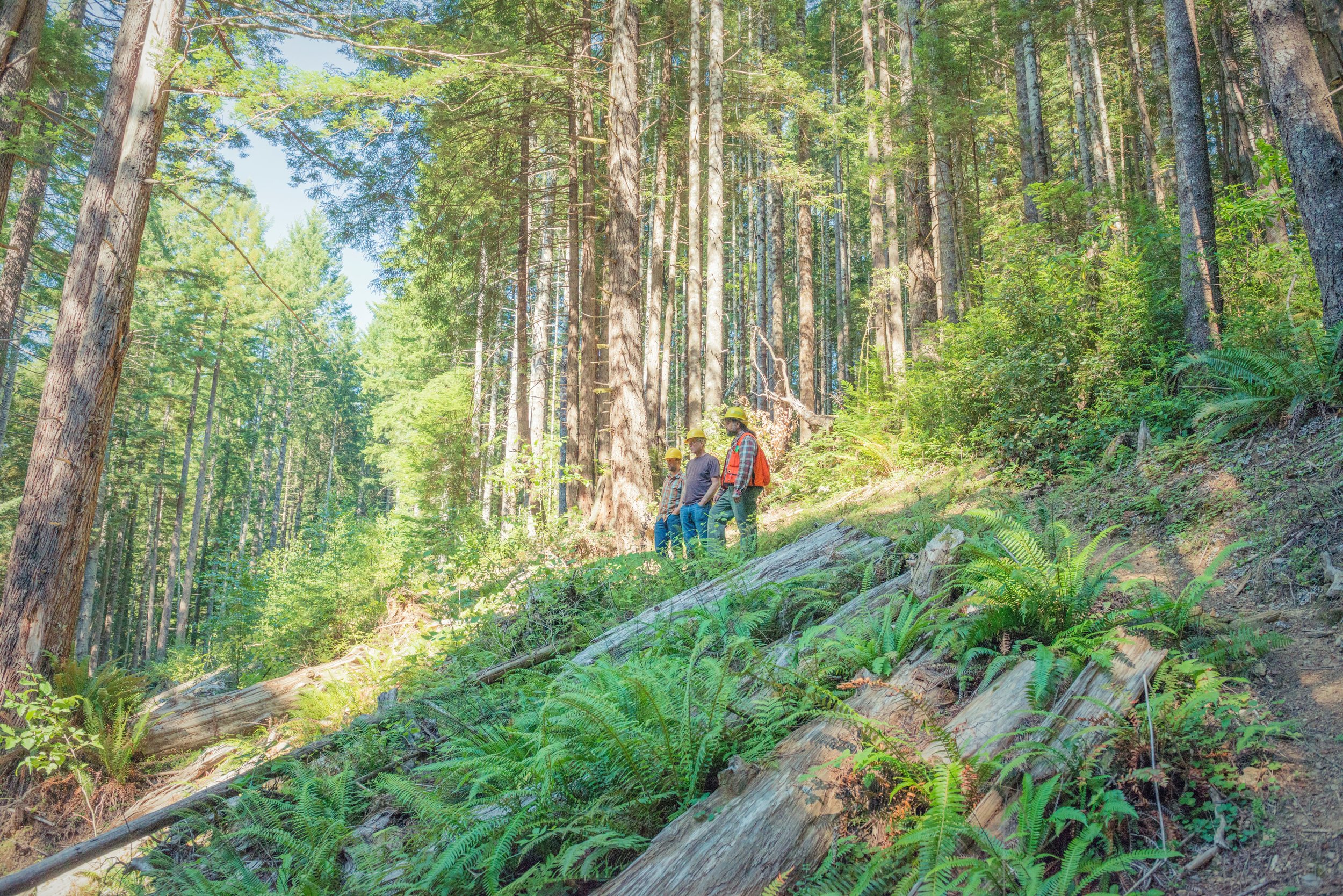Old‑growth redwood forests store more above‑ground carbon than any other forest type on Earth. Unfortunately, only 5% of old‑growth redwood forests survived extensive colonial logging in the 19th and 20th Centuries. Now, thanks in part to California Climate Investments funding awarded through CAL FIRE’s Forest Health Program, a partnership is working to establish the old‑growth forests of the future on California’s northern coast.
Redwood National and State Parks, in Humboldt and Del Norte counties, contain nearly 80,000 acres of second‑growth forest. These lands were heavily logged, indiscriminately re‑seeded, and fragmented by roads and stream crossings before they were designated as national and state parks. Because of this history of colonial resource extraction, the forests are now unhealthy and overgrown, making them susceptible to pests and wildfire. Abandoned roads throughout the parks continue to damage creeks and harm threatened and endangered fish species.
In 2018, Save the Redwoods League joined the National Park Service and California State Parks in an ambitious effort called Redwoods Rising. Together, the partners are working to rehabilitate more than 70,000 acres of second‑growth redwoods and remove 300 miles of roads over the next 30 years. Their goal: to set previously logged areas back on a trajectory towards old‑growth conditions and create landscapes that will be resilient in the face of climate change. In time, these restored ecosystems will provide the carbon sequestration, habitat, and cultural benefits of existing old‑growth forests.
California Climate Investments funding was used to launch the implementation of Redwoods Rising in late 2019, when CAL FIRE awarded a $7 million Forest Health grant to Save the Redwoods League. The partnership has since secured funding from a variety of federal, state, and private sources. Partner organizations are accomplishing forest restoration goals primarily through variable density thinning, which involves removing some small trees to redistribute growth among the remaining trees. This accelerates the development of old‑growth forest characteristics. Some trees removed from the project site are transported as logs to local sawmills, and the revenue generated from their sale is reinvested in the project.
Workers survey a previous road removal site in Redwood National Park where natural vegetation has grown back quickly, helping the forest’s recovery from previous fragmentation. Photo courtesy of Save the Redwoods League.
Redwoods Rising has already made impressive progress toward its long‑term goals. At a fifth‑anniversary event in late 2023, the partnership announced that it had completed forest restoration work on 3,200 acres in the Mill Creek and Prairie Creek watersheds, plus the removal and reforestation of 25 miles of roads. Most of the work to date was accomplished under the California Climate Investments grant.
CAL FIRE estimates that the initial grant‑funded treatments will sequester more than 84,000 MTCO2e over the project lifetime thanks to more vigorous tree growth and improved resilience to wildfire. The restored forests will also provide enhanced habitat for a variety of sensitive wildlife species.
Redwood National and State Parks superintendent Steve Mietz referred to the project as “the audacity of optimism” during the fifth‑anniversary event. “Facing the seemingly insurmountable challenges of climate change, wildfires, and tens of thousands of acres of unhealthy, second‑growth redwood forests, parks staff and partners pulled together to form a public‑private partnership that has engaged this monumental effort with grit and determination to achieve goals that could never be accomplished alone,” he said.
A former logging road decommissioned in Redwood National Park. Crews restored the shape of the original slope, then placed tree branches and logs on the finished slopes to stabilize the bare surface and provide intermediate habitat for wildlife. Photo courtesy of Save the Redwoods League.
Beyond its climate and biodiversity benefits, Redwoods Rising is also investing in the regional economy. The project provides direct employment, including for residents of nearby low‑income communities, and supports mills in the region through the sale of timber removed from the forest. The Redwoods Rising Apprenticeship Program gives students from Humboldt State University and College of the Redwoods hands‑on field experience to build the next generation of environmental scientists and stewards.
Redwoods Rising partners are prepared to continue this ambitious work. Another 43,000 acres are ready for restoration work, having met environmental permitting requirements. CAL FIRE awarded another Forest Health grant, this one providing General Fund dollars, to Save the Redwoods League in 2022, which will fund restoration work on nearly 2,000 more acres through 2025.
“The early and continued success of Redwoods Rising is based on building and maintaining relationships with regulatory agencies as well as the community,” said California State Parks North Coast District Superintendent Victor Bjelajac. “By consulting with regulatory agencies, the Redwoods Rising initiative has demonstrated the benefits of programmatic permitting and compliance to increase the pace and scale of restoration efforts.”



